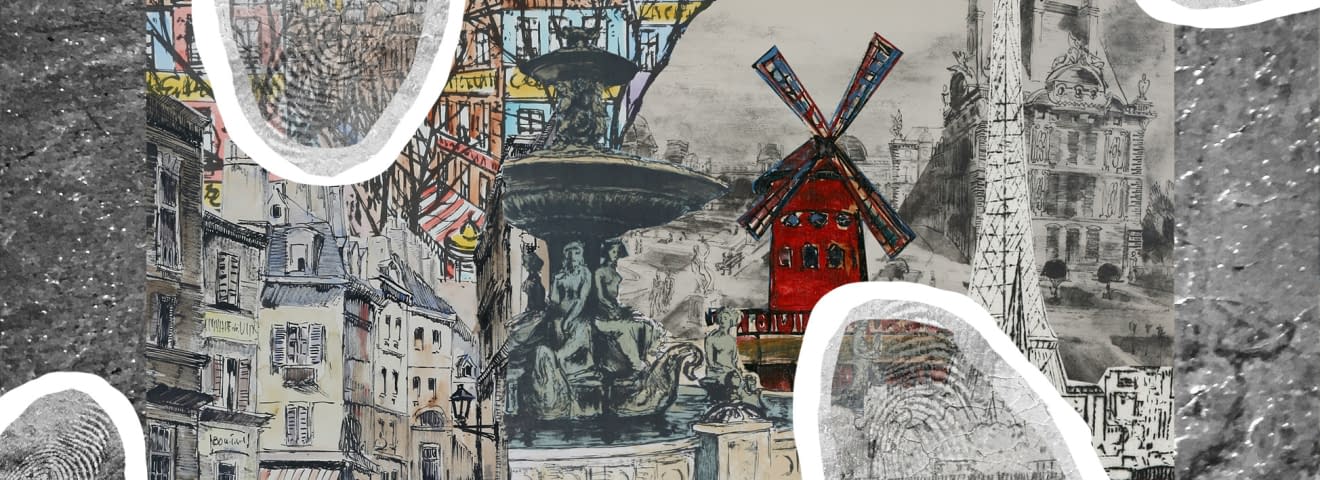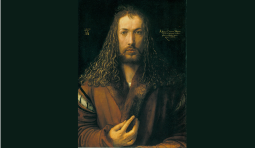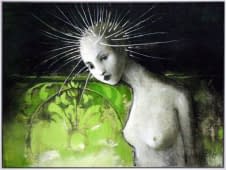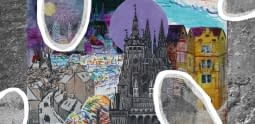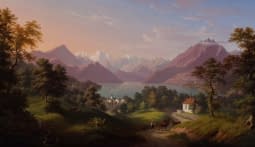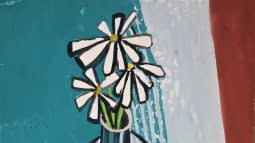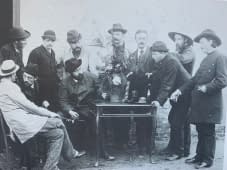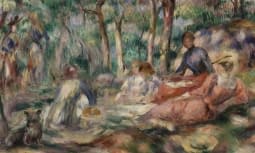On the Trail of #6 PARIS - The Significance of Paris for Modern Art | art24
The Significance of the City of Paris in Art
As part of the blog series " Following the traces of", we are now introducing you to a city, region or place that is special to the artists on art24. The art-historical significance of the location will also be analysed: What importance did the place play in art history and for the art scene? How did it influence and inspire the artists of the past and/or the artists of today and what significance does it have for the artists on art24?
Our First City: Paris the European Capital of Art
As the birthplace of modernism and for decades the "art capital of Europe", it is impossible to imagine Paris without modern art. Over the last two centuries, Montmarte and Montparnasse have developed into the most important art centres for abstraction, cubism, surrealism and the avant-garde. Find out here which artists on art24 were attracted to the two art districts and the revolutionising Parisian art scene.
Paris as the Pivotal Centre of Artistic Creation
Paris, the city of love. Probably the most visited city in Europe. The centre of artistic creation in the 19th and 20th centuries. Pictures by Monet, Renoir, Matisse, Chagall, Cézanne and Toulouse-Lautrec spring to mind. Names that are not unfamiliar to art lovers.
While France established the Rococo art style (18th century) from the Baroque period (17th century), when the Parisian artist Charles Le Brun played an important role, and artists such as Jean Siméon Chardin and Jean-Honoré Fragonard emerged as well-known Rococo painters, it was the second half of the 19th century and the first half of the 20th century that revolutionised the art scene. Today, this period is also known as the "Modern École de Paris".
Paris became the centre of art during this period. This is where the avant-garde took place. People came here to see the latest art and discover the newest artists. This is where the artists came to become famous and to soak up some of the city's fame and glamour. In other words, Paris was the Los Angeles of the 19th/20th century.
Paris - Venue for Six World Exhibitions
It was not without reason that the city served as the venue for six world exhibitions in 1855, 1867, 1878, 1889, 1900 and 1937. The French painter Paul Albert Baudouin took part in the 1899 world exhibition in Paris and won the gold medal for two of his panel paintings "L'Abreuvoir" (Engl. The Watering Place) and "Les Blanchisseuses" (Engl. The Laundresses). The titles indicate that these were depictions of everyday life in the 19th century. On art24, the French painter's work "Holzfäller Vorstudie" (Engl. Lumberjack preliminary study) can be found, which also immortalises the realism of the time.
Albert Samuel Anker: A Swiss Painter Studies in Paris
Probably the most important Swiss painter of realism is Albert Samuel Anker from Ins, Bern. He travelled to Paris for the first time in 1851. A few years later, he returned to Paris to study at the Ecole Impériale et Spéciale des Beaux-Arts, where he was taught by the Swiss Charles Gleyre, who later also taught Renoir. He remained in Paris until 1890 and was represented in many Parisian salons. Anker enjoyed his stay in the French city so much that he himself was once to say: "I live in Paris with body and soul and risk becoming completely Parisian". His contact with the metropolis of Paris and the classicist and impressionist artists working there influenced his painting style and his success as an artist. Through the gallery owner and art dealer Adolphe Goupil, he built up a Europe-wide clientele. He was no longer a stranger to the world; even Vincent van Gogh became a great fan of Anker.
Arthur Joseph Guéniot: Realist and Historicist Artist in Paris
Arthur Joseph Guéniot was an artist of realism and historicism who won several awards in France. Together with Matisse, Marquet and Rouault, he studied in Gustave Moreau's studio at the École des Beaux-Arts de Paris in 1892. He was a member of the Société des artistes francais and received a prize for his portrait painting, the medal of honour (1902), bronze medal (1920), silver medal (1925) of the Salon and a gold medal in 1927. A large number of his realistic and naturalistic drawings and studies can be found on art24.
Paris Revitalises the Art World with Pioneering Art Styles
France led the way for other European countries with innovative, powerful and distinctive art movements and revitalised the art world with completely new styles in a very short space of time. Over the course of roughly 70 years, pioneering artistic styles emerged in France that set themselves apart from previous and subsequent trends and stood the test of time with their confident, innovative character. The fertile period began with the emergence of realism by, among others by Gustave Courbet and the Paris Salons in the mid-19th century, continuing with Impressionism, which was characterised from the 1860s onwards by the Parisian artists Camille Pissarro, Edgar Degas, Claude Monet and Paul Gauguin, and reaching Symbolism, which spread from France at the World Exhibition in Paris in 1889, then to Art Nouveau 10 years later, which also gained Europe-wide attention at the World Exhibition in Paris (1900), and finally to Fauvism and Expressionism centred around the French painters Henri Matisse and Paul Cézanne at the beginning of the 20th century. This was followed by Futurism and Cubism, which predominated in the Parisian artists' colonies, and Surrealism, which was introduced in Paris around 1920 by the writer and critic André Breton and founded in 1924.
The art scene at the end of the 19th to the beginning of the 20th century Paris was thus the most important place of origin for the art movements of modernism and thus also attracted foreign artists who came to Paris not only out of curiosity, but also emigrated there for political reasons. Artists such as Picasso, Modigliani, Juan Gris and others emigrated to the French capital and really shook up the Parisian art scene.
In particular, the famous artists' quarters on Montmartre, which is still a focal point for young art today, and in the Montparnasse district, which boomed from the 19th century until the first half of the 20th century, became the most important centres of the art scene.
The Artists in Montmartre
Among the most famous artists' residences on Montmarte were "Le Bateau-Lavoir", the so-called birthplace of Cubism, inspired by Picasso, who was a co-tenant at the time, and "La Ruche", which housed the members of the later named "École de Paris", including Picasso, Guillaume Apollinaire, Chaim Soutine, Jules Pascin, Ferdinand Léger, Juan Gris, Henri Matisse, Marc Chagall, Marcel Duchamp, Ossip Zadkine, Joan Miró, Alexandre Calder, Alberto Giacometti, Salvador Dalí, and finally "Les Fusains", which was inhabited by André Derain and Pierre Bonnard, and later by Hans Arp, Sophie Taeuber-Arp, Max Ernst and Joan Miró.

In the 19th century, Montmartre was still a village on the outskirts of the capital, attracting countless artists who were able to lead a cheap and free life close to Paris. The neighbourhood underwent renovations and soon attracted painters such as Pierre-Auguste Renoir, Vincent van Gogh, Henri Toulouse-Lautrec, Picasso, Georges Braque, Amedeo Modigliani, Edgar Degas, Paul Cézanne, Émile Zola, Paul Gauguin, Pierre Seurat, Henri Matisse and Raoul Dufy.
The artists who came to Montmartre met and gathered in restaurants, cabarets, cafés and variety theatres such as "Le Moulin de la Galette", "Le Chat Noir" or the infamous "Le Moulin Rouge". Many world-famous works by the aforementioned artists, such as the painting "Bal du moulin de la Galette" by Pierre-Auguste Renoir from 1876 or the series of oil paintings "Le Moulin de la Galette" by Vincent van Gogh from 1886, were created here. The famous Art Nouveau poster "Tournée du Chat noir" by French artist Théophile Alexandre Steinlen from 1896 for the in-house Journal des Cabarets is the motif for "Le Chat Noir". Steinlen's rather gloomy realistic drawings of the war period can be found on art24.

Henri de Toulouse-Lautrec Inspired by Moulin Rouge
The dance evenings at the Moulin Rouge and the atmosphere at the Moulin de la Galette inspired Henri de Toulouse-Lautrec to create several works that are very well-known today, such as "Moulin de la Galette" (1889), "Au Moulin Rouge" (1892) from the Institute of Chicago and "At the Moulin Rouge, The Dance" (1890) from the Philadelphia Museum of Art. The Czech artist Frantisek Emler also depicted the Parisian variety theatre in his painting "Paris".

The hustle and bustle around Montmarte and the Sacré-coeur inspired the German foot painter Professor Arnulf Erich Stegmann to create his drawing "Viale a Montmartre".
Maximilian Hilpert: A Swiss Artist in Montmartre
The Swiss artist Maximilian Hilpert attended the art academy in Paris and was also linked to the artists' quarter on Montmartre. He stylised his magical dreamworld-like art made up of abstract, symbolic-figurative elements as self-proclaimed "Reabsolutism". The YouTube video "Saving Maximilian Hilpert from Oblivion" provides an insight into his art and his mysterious life.
Yves Corbassière, a Parisian dandy, was born in Montmartre in 1926. Although he spent his entire life in Paris, his abstract-expressive art became very well known in the USA. His work "Composition" belongs to Tachism, the so-called stain painting movement, which arrived in Paris from New York in the 1940s.
Born in Paris in 1932, Nathalie Chabrier on art24 began practising her art at the early age of five and discovered open-air painting on the Seine in Paris at the age of seven. She has attended several art schools in Paris since she was a teenager. Together with her husband, the painter Roger Forissier, she moved to the Cité Montmartre-aux-artistes in 1954. The circus became her favourite subject. In 1964, she accompanied the Knie Circus and later visited the Medrano Circus in Paris.
The Cité Montmartre-aux-artistes is an "artists' city" in Montmartre, a group of buildings with artists' studios built in 1932 in the Art Deco style according to the designs of the architect Adolphe Thieres. The three buildings contain 180 residential workshops, making it the largest artists' quarter in Europe. The artists' quarter was initially supported financially by a public limited company until 1936, when the public authorities of the city of Paris took over the deficit management of the building. The residence still serves as a living and working space for many artists today.
In addition to the artists' residences in Montmartre, it was the art schools that attracted artists to Paris for their studies. One of the most famous art academies was the Académie Julian, which opened in Montmartre in 1868 and trained numerous artists until 1939. Cuno Amiet and Giovanni Giacometti also decided together in 1888, impressed by French art, to continue their artistic training at the Académie Julian. Other notable teachers and students included Jean Arp, Pierre Bonnard, Marcel Duchamp, Käthe Kollwitz, Fernand Léger, Henri Matisse, Emil Nolde and many more.
The Artists in Montparnasse
At the beginning of the 20th century, artists left the Montmarte neighbourhood for the emerging artists' quarter in the Quartier du Montparnasse. As early as the 1830s, artists came to the new neighbourhood and set up their studios there. Filippo Colarossi's private art academy was established here in 1881, which was attended by Alfons Mucha, for example, and brought Paul Gauguin to Montparnasse as a teacher in 1891. The 1889 World Exhibition in Paris also attracted artists from all over the world to the Parisian neighbourhood. Life there was cheap and the nightlife was lively. The café "La Rotonde" on the Carrefour Vavin was a popular meeting place in the Quartier du Montparnasse.
Henry Maurice D'Anty was born in Paris in 1910. Here he attended the Ecole Supérieure de Commerce and later the Julian Academy of Fine Arts, but developed an affinity with the artists of the Académie de la Grande Chaumière on Montparnasse. This Académie was founded in 1904 by the Swiss artists Martha Stettler and Alice Dannenberg, who ran it until 1944. The art school taught well-known artists such as Germaine Richier, Alexander Calder, Amedeo Modigliani, Serge Poliakoff, Otto Ernst, Alberto Giacometti and Meret Oppenheim. Well-known teachers included Ossip Zadkine and Fernand Léger. In the early 1910s, Ossip Zadkine came to Montparnasse, where he became acquainted with the numerous artists and Cubists. He exhibited as part of the "Salon des Indépendants" and the "Salon d'Automne" and in 1928, together with his wife, opened his studio in Paris, which is now open as the Zadkine Museum.
Elisabeth Ivanovna Epstein, who came to Paris at the same time as Zadkine and acted as an important contact person for Kandinsky and Marc's Blue Rider group and thus as an intermediary for the Parisian art scene, was also present at the "Salon d'Automne". Our video "Saving Elisabeth Ivanovna Epstein from Oblivion" on YouTube offers an in-depth insight into her life. Another contemporary was Yves Alix, who trained in Paris at the Académie Julian, the École des Beaux-Arts and the Académie Ranson. From 1912, he regularly took part in the exhibitions of the "Salon des Indépendants", where he also became a committee member seven years later. Alix also joined the "Salon d'Automne" in 1921 and the "Union des Artistes Modernes" in the early 1930s.
Rudolf Zender on art24 also enjoyed his training at the Académie Ranson. He spent the majority of his life in Paris, where he worked as an artist in his studio. He returned to Switzerland for eight years when the war broke out and returned for good in 1982.
Félix Labisse returned to the French capital in 1940 after several previous stays and settled in Montparnasse in 1942. Although he was rejected by the Surrealist group around André Beton, he remained loyal to Surrealism and received support from his artist acquaintances such as René Magritte, Paul Delvaux, Max Ernst, Paul Eluard, Pablo Picasso and Robert Desnos. The Italian painter Leonor Fini on art24 also befriended the surrealist painters Max Ernst, Salvador Dalí and Man Ray in Paris around 1937, where and also in Monte Carlo she lived out her surrealist streak. The blog "Leonor Fini - The Surrealist Legend" offers a closer look at the artist's life and her significance for art. At the same time as Leonor Fini, Livinus van de Bundt came to Paris, where he began to study in what was then Paris Atelier 17. Like Fini, he also joined the Surrealists.
With the German occupation of France and the National Socialist invasion of Paris, the colourful artists' quarter collapsed, forcing many artists to flee. The once booming Montparnasse neighbourhood has never been able to recapture its former glory.
Paris as a Place of Encounter and Inspiration
In addition to the artists already mentioned, art24 also features numerous other artists who have spent an important part of their lives in the French capital.
Dan Solojoff was born in St. Petersburg, Russia. He had to deal with the horrors of wartime at an early age. When the civil war broke out in Russia, his family fled abroad. During the Second World War, he was deported to a German labour camp and was able to emigrate to Lyon, France, at the end of the Second World War before finally settling in Paris in 1960. Here he spent the last 34 years of his life. His art flourished again during this time and he created surrealist naïve works. The Russian avant-garde artist was "reborn" here. The artist's works on art24 all originate from this period. They contain playful details such as mermaids, tulips or water lilies, fish and moons. The gouache paintings shine in a luminous colouring on dark-toned grounds.
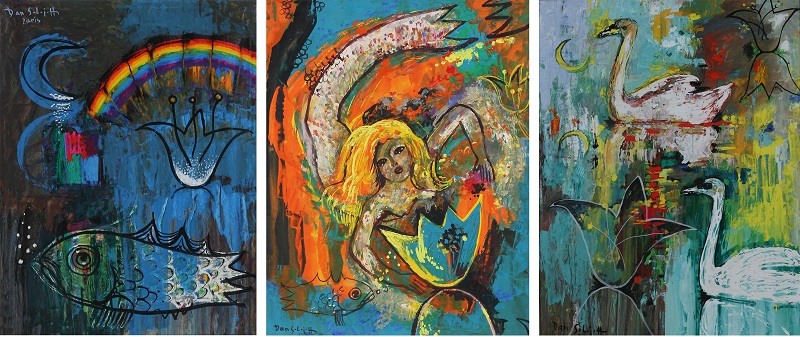
In the 1950s, the Polish-Canadian artist Zbigniew Kupczynski received the long-awaited recognition of his abstract expressionist art in his native Poland, which opened the doors to international attention for him. He received a state scholarship with which he continued his artistic training in the city of Paris. Kupczynski signed a contract with the André Schoeller Gallery and became an internationally sought-after artist. Alongside the painters Picasso, Braque, Miró and Chagall, his works are exhibited in the Philadelphia Museum of Art, for example. During his stay in Paris, he created the works "Head" and "Girl's Head with Bird".
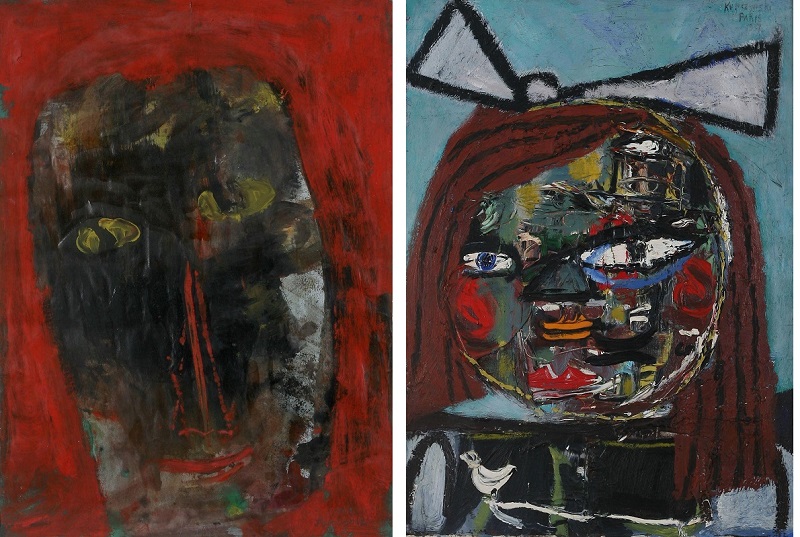
The Swiss artist Samuel Buri moved to Paris with his wife at the end of 1959. Under the influence of French painting and the prevailing contemporary art, Buri's abstract, colourful painting changed. It became more lyrical, more geometric, partly heraldic, and later more figurative again with Pop Art elements. The motifs are floral, everyday or include rural subjects. In addition to acrylic painting, he used stencils and other synthetic materials. He remained in Paris until 1971. Eight years later, he returned to Paris for a short stay, but lived in Basel from 1983.
Ten years after studying at the École des Beaux-Arts in Paris from 1958 to 1962, Marthe Brilman exhibited her works at art24 in Katia Granoff's art gallery until 1990, which secured her entry into professional life as a freelance artist. She sells her works to art collectors worldwide. She still works in her own studio in Paris today.
The appeal of Paris as a French city of art is not only reflected in the biographies of the artists. The works of art by Toulouse-Lautrec or Renoir mentioned at the beginning also show how much the city inspired them. The prints by modern contemporaries are a special feature of art24. We would like to draw particular attention to the following works:
The drypoint etching Eiffel Tower by the Czech graphic artist František Tichý, which portrays the unmistakable most famous landmark of Paris.
The print Fountain on the Place de la Concorde, Paris (99/200) by French artist Marc Aynard, which offers a view of the historic square where the execution of Marie Antoinette and Louis once took place.
The colour lithograph Paris (38/200), painted by Leo Maillet, showing Notre-Dame Cathedral from the park view.
The print Paris 171/200 by an unknown artist named I. Manz, which places the Parisian park "Jardin des Tuileries" at the centre of the picture. Here, Parisians stroll around the cooling fountain or in the shade of the garden.
The watercolour Paris Passage de la Petite Boucherie (Alley of the Little Butcher's Shop) by an unknown artist depicts a typically charming French alleyway located in the 6th arrondissement. Its name is characterised by the commercial nature of the street. Here, people displayed their wares in front of the windows under an awning.
The city not only inspired the artists of past centuries, but also the artists of today. It was and still is an important centre of art.
For example, the contemporary artist Eugen Meier Mathévie, who created the three-dimensional work Paris. The work shows the street network in abstract form around the famous roundabout of the Arc de Triomphe, from a bird's eye view.
Discover more artists and artworks on art24 who have portrayed Paris or have special links to the city.
Links for reference:
Kunstgeschichte: von der Antike bis in die Gegenwart (artinwords.de)
